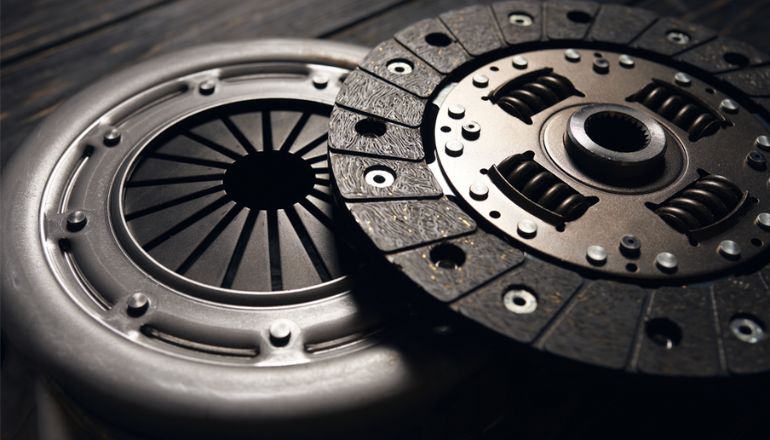An essential part of a manual gearbox system, the vehicle clutch ensures seamless gear changes and effective power transfer from the engine to the wheels. Drivers can activate or disengage the power gearbox using this device, which acts as a bridge between the engine and the gearbox.
Drivers can smoothly shift gears by depressing and releasing the clutch pedal. A smooth driving experience depends on knowing how the clutch operates and how to use it properly. The functions of an automobile clutch, its working process, and recommended procedures for preserving its longevity will all be covered in this blog.
Introduction to Car Clutch and its Importance
Given that a clutch transmits power from the engine to the gearbox and then to the wheels, it is an essential component of a car’s manual transmission system. It serves as an essential connection between the engine and the gearbox, allowing the driver to control power transfer and adjust gears easily. Let us now understand how a car clutch operates and discuss its importance to an automobile’s overall performance.
A vehicle clutch is essentially a mechanical part that is located between the engine and the gearbox. Among other crucial components, it has a clutch pedal, clutch disc, pressure plate, and flywheel.
The importance of a car clutch cannot be overstated. It allows the driver to seamlessly and precisely change gears, enabling them to adapt the engine’s speed to the desired vehicle speed. Without a clutch, gear changes would be jerky and ineffectual, making for a bad driving experience. By using the clutch, the driver can shift gears without harming the gearbox or other components of the drivetrain. The clutch, which is also a safety feature, allows the driver to disconnect the engine from the powertrain when coming to a stop or in an emergency.
An automobile clutch’s key benefit is its ability to quadruple torque. The engine’s power may be transferred to the wheels when the clutch is engaged due to friction between the clutch disc and flywheel. This torque multiplication is essential, particularly when a vehicle starts from a stop or ascends a steep slope. Without the clutch, the engine’s power would not be adequately transmitted to the wheels, which would cause sluggish acceleration and poorer overall performance.
According to car brake specialists in Adelaide, an automobile clutch’s function as a barrier between the powertrain and excessive wear and tear is another crucial feature. The clutch avoids abrupt jolts and shocks from being transferred through the drivetrain by disengaging the engine from the gearbox during gear changes. Due to this, the gearbox, driveshaft, and differential all see less wear and tear. Smoother shifts are guaranteed with proper clutch usage, extending the life of these vital powertrain components.
The clutch also enables accurate vehicle control under a variety of driving circumstances. The driver may modulate the amount of power sent to the wheels by varying when the clutch pedal is engaged and disengaged. When turning, driving off-road, or negotiating treacherous terrain, this control is very crucial. The driver may modify power delivery through the clutch, ensuring the best possible traction and manoeuvrability.
Car Clutch working process
Power may be transferred from the engine to the gearbox thanks to friction created between the clutch disc and the flywheel. This engagement process must occur for a seamless shift between gears. The clutch allows smooth gear changes without putting unnecessary strain on or harming the drivetrain’s components by synchronizing the engine’s and transmission’s rotational speeds.
Proper communication between the driver’s input on the clutch pedal and the clutch release mechanism is essential for seamless gear changes. To minimize abrupt movements or stop the engine, a fluid transition between gears largely depends on timing and modulation of the clutch pedal. Talk to a reputed mobile mechanic in Adelaide to learn more about the car clutch’s functioning and proper usage.
Habits that Can Damage Your Car Clutch
The manual gearbox system’s essential automobile clutch must be properly maintained and used to maximize lifetime and performance. However, if some behaviours are not changed, they may unintentionally harm the vehicle’s clutch. Let’s look at certain popular practices that can harm a car’s clutch:

1. Riding the Clutch
Constantly pressing the clutch pedal while driving, particularly when it’s not essential, will wear out the clutch disc excessively. This practice, referred to as “riding the clutch,” causes the clutch to remain partially engaged, increasing friction and heat production. This may eventually cause clutch slippage or early clutch wear. If you ever come across such a situation, it is important to look for car clutch repairs in Adelaide to get this issue resolved.
2. Resting Your Foot on the Clutch Pedal
Even when no pressure is applied, resting your foot on the pedal can cause “clutch drag.” This happens because the clutch disc has a tiny slip due to the pressure plate’s incomplete disengagement. Drag on the clutch creates friction and unnecessarily wears out the clutch parts.
3. Aggressive changing
Slamming the gears and changing when the clutch isn’t fully engaged might result in sudden motions and strain the clutch’s internals too much. This behaviour may result in gearbox problems, damaged clutch springs, or damage to the clutch plate. It’s critical to make smooth gear shifts and fully depress the clutch.
4. Downshifting without Rev Matching
Without correct rev matching, downshifting can result in sudden and asymmetrical changes in engine speed. Clutch shock and needless clutch disc wear may be caused due to downshifting, and these problems will require you to consult a mobile car repair near you. It’s crucial to re-match by blipping the throttle to match the engine speed with the lower gear before using the clutch to prevent this.
5. Using the Clutch to Hold the Car on Inclines
Using the clutch to hold the car still on grades rather than the brakes can put too much pressure on the clutch. This behaviour raises the risk of clutch slippage and early wear. When driving uphill, it is advised to hold the car using the brakes and only use the clutch when it is absolutely required to go off.
Also Read: Everything you need to know about Car Clutch
Conclusion
To sum up, the clutch in your car might suffer from several habits. For example, regular fluid checks and replacements can also result in premature wear and damage. Talk to a few car mechanics, compare the average cost of car inspection in your area, and have regular inspections to reduce the chances of wear and tear.
A typical poor practice called riding the clutch puts the system under undue stress, which can lead to overheating and premature damage. Poor shifting methods, such as accelerating too quickly or not fully engaging the clutch, can also eventually cause clutch damage. It is crucial to be aware of these behaviours and use the clutch correctly to guarantee the longevity and functionality of your car,
